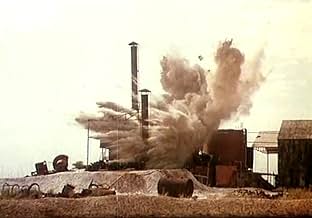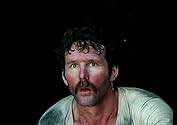AVALIAÇÃO DA IMDb
5,1/10
563
SUA AVALIAÇÃO
Adicionar um enredo no seu idiomaBecause of a severe drought in Kenya in 1984, ninety thousand starving baboons go on a murderous rampage, killing humans and animals alike.Because of a severe drought in Kenya in 1984, ninety thousand starving baboons go on a murderous rampage, killing humans and animals alike.Because of a severe drought in Kenya in 1984, ninety thousand starving baboons go on a murderous rampage, killing humans and animals alike.
- Direção
- Roteiristas
- Artistas
Percy Edwards
- Baboon voices
- (narração)
Carl Vundla
- District Officer Tshombe
- (não creditado)
- Direção
- Roteiristas
- Elenco e equipe completos
- Produção, bilheteria e muito mais no IMDbPro
Avaliações em destaque
Having spent a large part of my life in Kenya, this film made me afraid to set out into the Tsavo for years. Based on Events that I remember the old people talking about
the film integrates those stories with just the right amount
of fright!! The fear that the drought brought was displayed truthfully in this film. It captures the rugged beauty of the Kenyan countryside and people such as no other films made in Kenya have. If you have a fear of animals, this heightens it!
the film integrates those stories with just the right amount
of fright!! The fear that the drought brought was displayed truthfully in this film. It captures the rugged beauty of the Kenyan countryside and people such as no other films made in Kenya have. If you have a fear of animals, this heightens it!
Some of the reviews I encountered on "In the Shadow of Kilimanjaro" complain that baboons aren't convincing and not nearly menacing enough to pass for murderous animals. Well, this is a false impression in general. During a recent trip to South Africa I made a couple of excursions and the first thing the tour guides always warn you for are wild baboons. They are extremely aggressive animals and if they spot people with food in their hands, they will relentlessly attack and steal it from them. I'm not familiar with the supposedly true event this movie is based on, but I find it to be quite plausible and – even in case it never happened – it's a terrific plot outline for a mature and intellectual eco-horror movie anyway. The year is 1984 and Kenya, as well as the majority of the African continent, slowly cringes under a severe drought. It hasn't rained in months, the wildlife deteriorates, the animals are dying and a local community of mine workers do whatever they can to survive. They suddenly face an even more overpowering ordeal when all the baboons in the area, approximately 90.000, herd together and launch spontaneous attacks against the humans in their quest for food. "In the Shadow of Kilimanjaro" is a fairly odd and unusual 80's horror movie, since it doesn't aim for mindless shocks or bloody set-pieces, but merely thrives on atmosphere and educational values. The first half hour is really slow and moody, but this is mostly done to illustrate the atmosphere of drought and despair they characters find themselves trapped in. Once the baboons go on their virulent murder sprees, the film becomes more adventurous and horrific (with images of ripped off limbs and half-eaten faces) but still the violence never becomes gratuitous or overly exploitative. The make-up effects are effective and big kudos to the animal trainers, because a lot of footage was filmed using real animals. The mechanical baboons, used during the more complicated attack scenes, are definitely convincing as well. This mainly African-produced film features two international stars delivering more than adequate performances, namely Timothy Bottoms as a park supervisor (and kind of looking like a big ape himself, what with the ferocious beard) and John Rhys-Davies as the demanding mine owner. "In the Shadow of Kilimanjaro" is a good and original film, naturally benefiting the most of the wonderful scenery and exterior filming locations, but also boosting a unique storyline and multiple moments of great suspense.
The basic plot of IN THE SHADOW OF KILIMANJARO (1986) is that an army of crazed, homicidal babboons are killing folks left and right in the middle of nowhere. The thing the filmmakers should of realised is that babboons always look kind of bored. An example comes in one scene where a movie character has a flat tire in the desert. We cut to shots of yawning, pre-occupied looking monkeys watch him from afar. They seem to be saying "Hoo-Hummm, I dunno, should I kill him? I don't know, rather sit here and pick flies off my fur. (Yawn....) Okay. Let me go down and kill 'em." We had a good laugh with this one.
This movie is suppose to tell the true tale about how 90,000 baboons went on a killing spree because of a severe drought in 1984. This movie bombed badly at the theaters. And it bombs badly as a movie itself. Did this really happen, I don't know. This movie is good for a laugh.
Michele returned to Hollywood for one final appearance after a short hiatus to raise her son as he was a high school student at the time of the films production.
Michele was excited to travel to Kenya for the filming but was disappointed with its final presentation.
Michele officially retired from acting within days of returning to her home in California.
Michele passed away on November 21st, 2018 at the age of 75 having never returned to her acting career.
Michele was excited to travel to Kenya for the filming but was disappointed with its final presentation.
Michele officially retired from acting within days of returning to her home in California.
Michele passed away on November 21st, 2018 at the age of 75 having never returned to her acting career.
Você sabia?
- Curiosidades[Postscript] The film you have just seen is a fictionalized account of a true incident which took place in Africa during the serious drought in 1984. The producers wish to make it known that not a single animal was mistreated during the making of this motion picture. On completion of filming the Baboons were rehabilitated to their natural surroundings. The Baboons were captured under the supervision of the Kenyan Ministry of Tourism and Wildlife from the areas where they had been a nuisance to the local population.
- Cenas durante ou pós-créditos[Postscript] The film you have just seen is a fictionalized account of a true incident which took place in Africa during the serious drought in 1984. The producers wish to make it known that not a single animal was mistreated during the making of this motion picture. On completion of filming, the Baboons were rehabilitated to their natural surroundings. The Baboons were captured under the supervision of the Kenyan Ministry of Tourism and Wildlife from the areas where they had been a nuisance to the local population.
- ConexõesFeatured in Trailer Trauma 3: 80s Horrorthon (2017)
- Trilhas sonorasIn the Shadow of the Kilimanjaro
Words and Music by Chieli Minucci & Allan Smallwood
Principais escolhas
Faça login para avaliar e ver a lista de recomendações personalizadas
- How long is In the Shadow of Kilimanjaro?Fornecido pela Alexa
Detalhes
Bilheteria
- Faturamento bruto nos EUA e Canadá
- US$ 181.410
- Fim de semana de estreia nos EUA e Canadá
- US$ 181.410
- 11 de mai. de 1986
Contribua para esta página
Sugerir uma alteração ou adicionar conteúdo ausente















